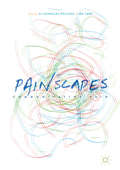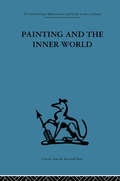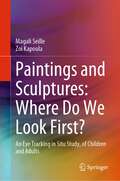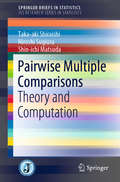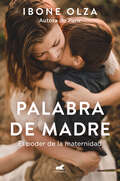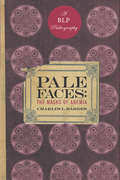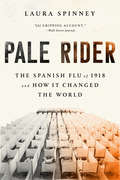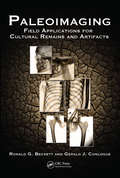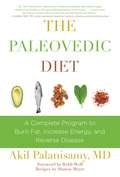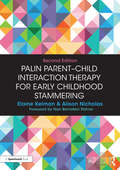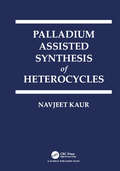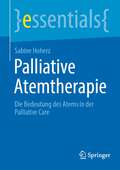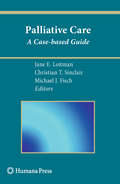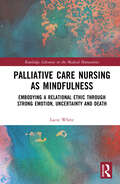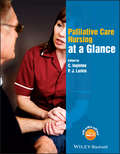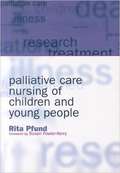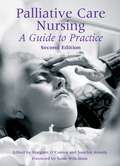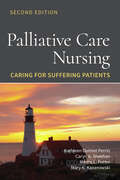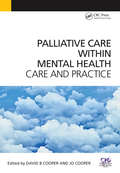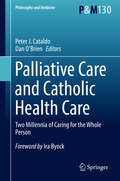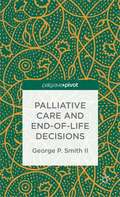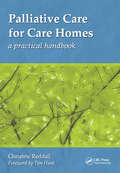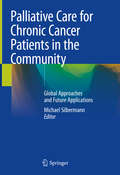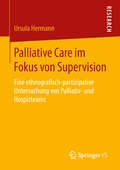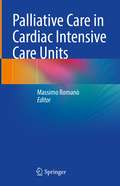- Table View
- List View
Painscapes
by Ej Gonzalez-Polledo Jen TarrThis book brings into dialogue approaches from anthropology, sociology, visual art, theatre, and literature to question what kinds of relations, frames and politics constitute pain across disciplines and methodologies. Each chapter offers a unique window onto the notoriously difficult problem of how pain is defined and communicated. The contributors reimagine the value of images and photography, poetry, history, drama, stories and interviews, not as 'better' representations of the pain experience, but as devices to navigate the complexity of pain across different physical, social, and intersubjective domains. This innovative collection provides a new access point to the phenomenon of pain and the materialities, affects, structures and institutions that constitute it. This book will appeal to readers seeking to better understand pain's complexity and the social and affective ecologies through which pain is known, communicated and lived.
Painting and the Inner World (International Behavioural And Social Sciences Ser. #Vol. 99)
by Adrian StokesTavistock Press was established as a co-operative venture between the Tavistock Institute and Routledge & Kegan Paul (RKP) in the 1950s to produce a series of major contributions across the social sciences. This volume is part of a 2001 reissue of a selection of those important works which have since gone out of print, or are difficult to locate. Published by Routledge, 112 volumes in total are being brought together under the name The International Behavioural and Social Sciences Library: Classics from the Tavistock Press. Reproduced here in facsimile, this volume was originally published in 1963 and is available individually. The collection is also available in a number of themed mini-sets of between 5 and 13 volumes, or as a complete collection.
Paintings and Sculptures: An Eye Tracking in Situ Study, of Children and Adults
by Magali Seille Zoi KapoulaThe book presents three studies in which eye tracking data were collected at the Musée des Beaux-Arts in Rouen in June and July 2013. Overall, the results of those three studies highlight the knowledge gained from the analysis of the very first saccade in a museum context, when people look at paintings and statues. The first study analyzes how viewers orient their first saccade on paintings. This study shows that, in a museum, the first saccade is attracted toward the center of paintings. This attraction toward the paintings’ center is found in all the subjects’ groups that we have studied. Noteworthily, this effect is significantly less pronounced in individuals who never visit museums. It is among amateurs, who often visit museums, that the center attracts the most the first saccade. Among experts, painters or art history teachers, and to a lesser extent among amateurs, the pictorial composition largely determines the orientation of the first saccade. We indeed found that, as soon as the first saccade, experts orient their gaze toward the main subject. This phenomenon seems to be explained by the fact that experts immediately orient their gaze (here measured as the first saccade) toward the paintings’ location conveying the most meaning. It can either be the center, or a peripheral area, depending on whether the paintings’ most meaningful subject is located centrally or peripherally. The second study shows that the center does not attract the first saccade in 5-year-old children. This behavior appears later, in 8- to 10-year-old children. However, noticeably, the 8–10-year-old children orient significantly less frequently their first saccade toward the paintings’ center as adults do, and this is also true when one considers non-expert adult viewers. The results of the third study focus on statues and reveal a very different oculomotor behavior: Indeed, rather than looking at the center, statues’ viewers exhibit a clear tendency to saccade first at the statues’ contours. This stands in contrast with the behavior that we observe with paintings. Our study concludes that statues trigger a specific oculomotor behavior. The latter appears to be mostly driven by the physical presence that stone bodies incarnate. The movement and the climax of this movement, that sculptors manage to convey, thus turn out to attract the gaze in a unique fashion. The book concludes that the first saccade is a powerful indicator of the oculomotor behavior that greatly improves our comprehension of the unique relationship between a viewer and artworks.
Pairwise Multiple Comparisons: Theory and Computation (SpringerBriefs in Statistics)
by Hiroshi Sugiura Taka-aki Shiraishi Shin-ichi MatsudaThis book focuses on all-pairwise multiple comparisons of means in multi-sample models, introducing closed testing procedures based on maximum absolute values of some two-sample t-test statistics and on F-test statistics in homoscedastic multi-sample models. It shows that (1) the multi-step procedures are more powerful than single-step procedures and the Ryan/Einot–Gabriel/Welsh tests, and (2) the confidence regions induced by the multi-step procedures are equivalent to simultaneous confidence intervals. Next, it describes the multi-step test procedure in heteroscedastic multi-sample models, which is superior to the single-step Games–Howell procedure. In the context of simple ordered restrictions of means, the authors also discuss closed testing procedures based on maximum values of two-sample one-sided t-test statistics and based on Bartholomew's statistics. Furthermore, the book presents distribution-free procedures and describes simulation studies performed under the null hypothesis and some alternative hypotheses. Although single-step multiple comparison procedures are generally used, the closed testing procedures described are more powerful than the single-step procedures. In order to execute the multiple comparison procedures, the upper 100α percentiles of the complicated distributions are required. Classical integral formulas such as Simpson's rule and the Gaussian rule have been used for the calculation of the integral transform that appears in statistical calculations. However, these formulas are not effective for the complicated distribution. As such, the authors introduce the sinc method, which is optimal in terms of accuracy and computational cost.
Palabra de madre: El poder de la maternidad
by Ibone Olza¿Qué es ser madre? Palabra de madre parte de la historia personal de la autora, como madre y como profesional de la sanidad y activista, para plantear sus contradicciones e indecisiones en torno a la experiencia maternal, así como su desconcierto acerca de cómo los sistemas de salud de nuestra sociedad han ignorado y boicoteado la sabiduría reunida en relación con ella. «Me gustaría comprender qué clase de madre he sido. Captar, aunque sea de manera fugaz, el núcleo de mi experiencia maternal. Y así, de paso, comprender mejor la experiencia maternal en su sentido más amplio: la de todas las madres. Empecé a ser consciente de la profunda escisión, de cómo los sistemas de salud han ignorado a las madres y negado sus experiencias y conocimientos, y de cómo la ausencia de ese conocimiento maternal ha dado lugar a una ciencia sesgada y en muchos casos dañina. Todo ese conocimiento basado en la evidencia científica se estrella a diario contra la realidad de una sociedad heredera de décadas y siglos de desprecio hacia la maternidad.» Así, las circunstancias personales de cada madre, a menudo tortuosas y adversas, adquieren otro matiz cuando las analizamos desde lo histórico-social. «Mis circunstancias... Tendré que volver sobre ellas para lo que me propongo: comprender a la madre que fui y a la que ahora soy, con la esperanza de que tal vez sirva para entender y cuidar mejor al resto de las madres». Sobre Palabra de madre: «Todas las madres nos merecemos este libro. Porque todas sin excepción necesitamos estas palabras balsámicas para aplacar las soledades de la maternidad contemporánea. Ibone Olza nos regala un espejo de vivencias, luchas,intuiciones, dudas y cicatrices, que de tan propias se convierten en colectivas. Este libro viene a politizar la culpa endémica (y algunas otras heridas) que se nos inocula desde una sociedad profundamente maternofóbica. Y lo hace con toda la potencia de la ternura, la empatía radical y una catártica escritura».Silvia Nanclares, autora de Quién quiere ser madre «Palabra de madre es un libro honesto y emocionante, político y poético, capaz de acompañar a todas las madres que tienen todavía heridas abiertas en el cuerpo y en la memoria. Ibone Olza ha escrito este libro para todas nosotras. Y también para una sociedad que sigue dando la espalda a las madres».Carmen G. de la Cueva, autora de Mamá, quiero ser feminista
Pale Faces
by Charles L. BardesWho would have thought that something so commonplace as iron deficiency would lead to prehistoric ochre, Egyptian amulets, Renaissance alchemy, Victorian projections of maidenhood, and the astrophysical end of everything?Whether mild or deadly, anemia affects an essential body fluid: blood. In Pale Faces, Charles L. Bardes probes deeply into this illness as metaphor by exploring the impact of both science and culture on its treatment across the ages. His innovative "life" of this condition ranges widely through history, mythology, literature and clinical practice to examine how our notions of specific medical conditions are often deeply rooted in language, symbolism and culture.Delving into the annals of anemia and its treatment, he takes us on a fascinating journey back through the history of medicine-from the Greeks and ancient practices of bloodletting and magic up to the diagnostic rituals of a modern medical office. A scholar of the literary as well as the medical arts, Bardes gives us a beautifully written, free-ranging text, resonant with poetic associations yet anchored in concrete clinical experience.As a practicing physician, Bardes is also able to draw upon his direct experience with patients to demystify the doctor/patient relationship. Through detailed descriptions of the diagnostic processes involved in blood related conditions, as well as the particular understanding of the inner workings of the human body provided by modern medical science, we are treated to the complex ways in which doctors think.Charles L. Bardes, MD, is a practicing physician who teaches extensively at Weill Cornell Medical College, where he directs the Medicine Clerkship and serves as Associate Dean. He is the author of Essential Skills in Clinical Medicine, a guide for students and interns, and Pale Faces: The Masks of Anemia, the first book in the Bellevue Literary Press Pathographies series. He has been the Bernard DeVoto Fellow in Nonfiction at the Bread Loaf Writers' Conference and his essays have appeared in numerous journals, including Agni. He lives in New York.
Pale Rider: The Spanish Flu of 1918 and How It Changed the World
by Laura SpinneyIn 1918, the Italian-Americans of New York, the Yupik of Alaska and the Persians of Mashed had almost nothing in common except for a virus--one that triggered the worst pandemic of modern times and had a decisive effect on the history of the twentieth century. The flu pandemic of 1918-1920 was one of the greatest human disasters of all time. It infected a third of the people on Earth—from the poorest immigrants of New York City to the king of Spain, Franz Kafka, Mahatma Gandhi, and Woodrow Wilson. But despite a death toll of between 50 and 100 million people, it exists in our memory as an afterthought to World War I. In this gripping narrative history, Laura Spinney traces the overlooked pandemic to reveal how the virus traveled across the globe, exposing mankind&’s vulnerability and putting our ingenuity to the test. Drawing on the latest research in history, virology, epidemiology, psychology, and economics, Pale Rider masterfully recounts the little-known catastrophe that forever changed humanity.
Paleoimaging: Field Applications for Cultural Remains and Artifacts
by Ronald G. Beckett Gerald J. ConlogueMedical and industrial imaging methods have come to be recognized as powerful tools for documentation and data collection in many nontraditional settings. In Paleoimaging: Field Applications for Cultural Remains and Artifacts, two of the most preeminent experts in the field provide an in-depth examination of a range of imaging techniques and explain how these techniques can be applied to all aspects of forensic and archaeological analysis.The first part of the book examines paleoimaging multimodalities, highlighting the advantages and disadvantages of each imaging technique in different scenarios. The authors explore photography, conventional radiography, endoscopy, and various forms of computer-based imaging. Next, they present methodological and procedural standards for the various imaging techniques. They also demonstrate how multimodal imaging can assist nondestructive data collection of non-biological cultural artefacts. A final section addresses radiation safety and field safety concerns. Case studies, tables, and templates of forms for documentation of findings enhance the text with practical information.Filled with over 380 images, this book is supplemented with an accompanying downloadable resource in which the authors draw from their global experience in the paleoimaging of cultural remains and artefacts, offering a view of the diverse environments in which field paleoimaging is conducted. The breadth of the authors’ expertise and the rich images contained in the book and downloadable resources make this resource an essential reference for those who seek to explore the mysteries of the past.
Paleovedic Diet: A Complete Program to Burn Fat, Increase Energy, and Reverse Disease
by Akil PalanisamyA groundbreaking total-body program that incorporates principles of Paleo nutrition, Ayurvedic medicine, and cutting-edge research. In The Paleovedic Diet, Dr. Akil Palanisamy, MD, offers a comprehensive roadmap to optimal health combining the most effective aspects of the Paleo diet with Ayurveda, the time-tested traditional medical system of India, and the latest scientific research. Making complex ideas understandable and accessible, Dr. Akil delivers a simple, customized diet and lifestyle program to fit your unique body type. Drawing upon on his extensive training and clinical experience, Dr. Akil skillfully separates fact from fiction, providing clarity on issues such as gluten sensitivity, misconceptions about carbs, meat-eating versus vegetarianism, good and bad fats, unknown superfoods (you’ll be surprised to see what’s included), nutritional supplements, and the critically important gut bacteria comprising your microbiome. The Paleovedic Diet provides definitive, practical guidance on what to eat, how to move, how to sleep, how to manage stress, and even how to breathe. Dr. Akil's revolutionary three-week program (with meal plan and recipes) utilizes delicious nourishing foods, powerful healing spices, and intensive detoxification techniques to help you transform your body and mind.
Palin Parent-Child Interaction Therapy for Early Childhood Stammering
by Elaine Kelman Alison NicholasNow available in a fully revised and updated second edition, this practical manual is a detailed guide to the Palin Parent–Child Interaction Therapy programme (Palin PCI) developed at the Michael Palin Centre for Stammering (MPC). Palin PCI builds on the principle that parents play a critical role in effective therapy and that understanding and managing stammering is a collaborative journey between the child, parent and therapist. This book emphasises a need for open communication about stammering, offering a combination of indirect techniques such as video feedback, interaction strategies and confidence building, along with direct techniques to teach a child what they can do to help themselves. This second edition: Reflects the most up-to-date research in areas such as neurology, genetics, temperament and the impact of stammering on children and their families Offers photocopiable resources, such as assessment tools, information sheets and therapy handouts, to support the implementation of Palin PCI Focuses on empowerment through building communication confidence in children who stammer and developing knowledge and confidence in their parents Based on a strong theoretical framework, this book offers a comprehensive understanding of the Palin PCI approach in order to support generalist and specialist speech and language therapists as they develop their knowledge, skills and confidence in working with young children who stammer and their families.
Palladium Assisted Synthesis of Heterocycles
by Navjeet KaurThis book is a compilation of the recent applications of palladium catalysts in organic synthesis. The book demonstrates that it is a highly dynamic research field. This methodology has emerged as a powerful tool for the efficient and chemoselective synthesis of heterocyclic molecules. In the past few years, several strategies have been pointed out to pursue more efficient, sustainable, and environment friendly chemical processes. Among those strategies, catalysis and the design of new processes that avoid the use of toxic reagents have been the focus of intense research.
Palliative Atemtherapie: Die Bedeutung des Atems in der Palliative Care (essentials)
by Sabine HoherzIn diesem essential erfahren Sie, welche Bedeutung der Atem für den Menschen und insbesondere für Schwerstkranke und Sterbende hat. Der Band beschreibt die Grundlagen und Wurzeln der Palliativen Atemtherapie, ihre Wirkfelder und die Möglichkeiten ihrer Anwendung und vermittelt, was die Therapieform für Schwerstkranke und ihre Angehörigen zu leisten vermag. Auch die tiefgreifende spirituelle Dimension wird beschrieben, in der die Palliative Atemtherapie ihre Wirkung entfalten und den sterbenden Menschen auf heilsame Weise berühren kann.
Palliative Care
by Michael J. Fisch Jane E. Loitman Christian T. SinclairThis concise book offers an engaging case-based approach to palliative care. Experts in the field provide the essential aspects of daily practice with real cases presented as forums for the discussion of the complexities and practicalities of palliative treatment. Clearly structured, each chapter opens with bullet points highlighting the most relevant aspects of the case and points for discussion. Covering the full range of symptoms from cardiac care to pain management to wound healing, the vital elements of management are put into context through insightful dissections of history, examination, and goals of care. Each chapter concludes with a section on further reading. Palliative Care: a Case-based Guide provides the clinician with a crucial set of skills to address the challenging issues related to communication and symptom management. Care-oriented and practical, this book is ideal for all health care professionals committed to providing quality, compassionate care to end-of-life patients.
Palliative Care Nursing as Mindfulness: Embodying a Relational Ethic through Strong Emotion, Uncertainty and Death (Routledge Advances in the Medical Humanities)
by Lacie WhiteAs nurses, we hear about mindfulness all the time, but what does that actually mean in practice? In this book readers are invited into conversation to explore how mindfulness influences palliative care nurses’ approaches to caring for themselves and others through experiences of living-dying. Under the guise of stress reduction and self-care, the assumption often made is that mindfulness can smooth out difficult experiences. Instead, the objective of this inquiry is not to bypass the practice of caring in those spaces that are really hard, but to understand how nurses are working directly within them. Calling out from the shadows—and our bodies—the intensity of palliative care nursing practice arises. In this text, a dialogue unfolds of nurses caring in deeply meaningful practice environments while searching for ground that is perpetually shifting, uncertain, and fraught with suffering and strong emotion. Integrating literature across nursing, sociology, and contemplative scholarship, evocative stories from palliative care nurses lead in this conversation—their words in italics—showing how they are guided into action through connection with-in their bodies. At other times, stories show how nurses are taking pause and drawing on various somatic practices to unravel entanglements that touch on their own humanity. These stories also offer insight into how systemic forces, across educational and organizational institutions, are either enhancing or constraining the way nurses engage mindfulness as a relationally embodied ethic of care. This insightful volume is not a how-to guide, rather it is a timely resource exploring approaches for palliative care nurses to care for themselves and others with mindfulness and compassion. Those seeking nuanced perspectives, particularly in relation to embodying mindfulness through suffering and strong emotion, will be drawn to this text. Qualitative researchers studying emotionally sensitive topics may also find inspiration in the narrative, arts-based, and embodied methods that shape this inquiry.
Palliative Care Nursing at a Glance
by P. J. Larkin C. IngletonPalliative Care Nursing at a Glance is the perfect companion for nursing students, health and social care practitioners, and all those involved in palliative care delivery, both in the clinical and home setting. Written by an expert team of academics, nurses, educators and researchers it provides a concise and easy-to-read overview of all the concepts and clinical decision-making skills necessary for the provision of good-quality palliative and end-of-life care. Divided into six sections, the book includes coverage of all key clinical applications, principles of symptom management, palliative care approaches for a range of conditions and patient groups, exploration of the roles of the multi-professional team, as well as ethical challenges. Superbly illustrated, with full colour illustrations throughout Provides information on delivery of care in a range of settings Broad coverage makes it ideal reading for anyone involved in palliative care delivery User-friendly and accessible resource for those working in both specialist and non-specialist adult settings
Palliative Care Nursing of Children and Young People
by Rita Pfund"Children's palliative care is an evolving specialty and as such our knowledge base cannot remain static. This book constantly challenges the reader to critically analyze their own practices and beliefs within an evidence-based framework and as such makes a valuable contribution to the growing body of knowledge on this important subject." - Susan Fowler-Kerry, in the Foreword. This book caters for readers from different working environments and levels of experience. It is ideal for paediatric nurses with no specialist palliative care knowledge, and also for palliative care nurses with no specialist paediatric experience. Other healthcare professionals and therapists working with children, young people and their families will also find this book invaluable. It will also be ideal for undergraduate and postgraduate health and social care students, and professionals involved in children's hospices, community services and charity groups. "This book captures not just the rapidly evolving evidence base, but also as many current developments as possible and applies them in a meaningful way to the care of infants, children, and young people living with life-limiting illness, and their families. It offers an overview of contemporary issues and helps to stimulate the type of dialogue that can bring about the actions that will make a real difference for the children, young people and families in our care." - Rita Pfund, in the Preface.
Palliative Care Nursing: A Guide to Practice
by O’Connor Margaret Aranda SanchiaWritten by experienced authorities from around the world giving a wider international perspective on palliative nursing, this substantially expanded new edition has been specifically adapted to reflect working practices within the NHS. All nurses especially those that are new to palliative care, and those working in other areas of health where palliative skills are required, will find this essential reading.
Palliative Care Nursing: Caring for Suffering Patients
by Kathleen Ouimet Perrin Caryn A. Sheehan Mertie L. Potter Mary K. KazanowskiAwarded first place in the 2022 AJN Book of the Year Awards in the Palliative Care and Hospice category.Preparing Nurses to Care for the Seriously Ill and their FamiliesPalliative Care Nursing: Caring for Suffering Patients continues to explore the concept of suffering as it relates to nursing practice in an updated new edition. This text helps practicing nurses and students define and recognize various aspects of suffering across the lifespan and within various patient populations, while providing guidance in alleviating suffering. In addition, the authors discuss ways nurses that witness suffering can optimize their own coping skills and facilitate personal growth. The Second Edition aligns with the recently updated ELNEC and AACN competencies and features three new chapters discussing advance care planning, palliative care for those with serious illnesses, and strategies for having difficult conversations with patients and families.How do we identify a patient who is suffering? How do we assess whether our patient (and/or their family) is coping with the event? What can we do to alleviate patient suffering? How can we convey the extent of the suffering to the other members of the healthcare team and advocate excellent palliative care for our patients? Palliative Care Nursing: Caring for Suffering Patients, Second Edition answers these questions and more, making it an indispensable resource for nursing students and nurses employed in a variety of health care settings. Updated to align with the recently revised ELNEC and AACN competenciesFeatures features three NEW chapters discussing advance care planning, palliative care for those with serious illnesses, and strategies for having difficult conversations with patients and familiesExplores physical, psychological, sociocultural, developmental, and spiritual sufferingIncludes new discussions on compassion fatigue and burnout, options for effective management of chronic pain, logotherapy, a new assessment of patient comfort, and moreRich in case studies, exercises, pictures, and reflections on nursing practice and life experiences This text is ideal for gerontology, palliative care nursing courses, capstone courses, and undergraduate nursing courses dealing with end of life issues, psychology, grieving, and palliative care. © 2023 | 400 pages
Palliative Care Within Mental Health: Care and Practice (Radcliffe Ser.)
by David Cooper Jo CooperThis thought provoking and highly practical book is not just about caring for the dying within mental health, but also applying the quality care and practice of palliative care within mental health practice. Multidisciplinary in its approach, it focuses on intervention, treatment, care and practice, and the similarities in practice between palliative care and mental health. This common ground is an excellent foundation for integrating palliative care into mental health care, practice and service delivery, succinctly covering all aspects of psychological, physical, social, spiritual, sexual and emotional health. Featuring authoritative contributions from international experts, each chapter develops a theoretical framework before broadening its scope to include application in practice - addressing what, when, where and why with a definite focus on implementation in practice. Self-assessment exercises, advice for further reading, ideas for reflective practice and summaries of key points are also included, aiming above all else to improve the relationships, responses, care and practice necessary to be effective in interventions and treatment with those experiencing mental health concerns and dilemmas. Ideal for all health, social, psychological, legal and spiritual care students and professionals wanting sound theoretical and practical guidance, this book is highly recommended for General Practitioners and General Practice Registrars, healthcare assistants studying NVQ and health visitors. Educationalists, managers and service developers in health and social care will also appreciate its solution-focused, practical approach.
Palliative Care and Catholic Health Care: Two Millennia of Caring for the Whole Person (Philosophy and Medicine #130)
by Peter J. Cataldo Dan O’BrienThis book offers a comprehensive overview of the compatibility of palliative care with the vision of human dignity in the Catholic moral and theological traditions. The unique value of this book is that it presents expert analysis of the major domains of palliative care and how they are compatible with, and enhanced by, the holistic vision of the human person in Catholic health care. This volume will serve as a critically important ethical and theological resource on palliative care, including care at the end of life, for bioethicists, theologians, palliative care specialists, other health care professionals, Catholic health care sponsors, health care administrators and executives, clergy, and students. Patients receiving palliative care and their families will also find this book to be a clarifying and reassuring resource.
Palliative Care and End-of-Life Decisions
by Ii George P. SmithTotal pain management mandates that an ethic of adjusted care be implemented at the end-stage of life which acknowledges ethically, legally, and clinically the use of terminal sedation as efficacious treatment.
Palliative Care for Care Homes: A Practical Handbook
by Christine ReddallCare home workers increasingly work with people nearing the end of their lives, including people with medically complex conditions. However, many do not have a medical background and find that practical advice on how to address these people's very specific needs is scarce. In this book, Christine Reddall draws on almost four decades of nursing expe
Palliative Care for Chronic Cancer Patients in the Community: Global Approaches and Future Applications
by Michael SilbermannThe new global cancer data suggests that the global burden has risen to 18.1 million new cases per year and 9.6 million cancer deaths per year. A number of factors appear to be driving this increase, in particular, a growing and aging global population and an increase of exposure to cancer risk factors linked to social and economic development. For rapidly-growing economies, the data suggests a shift from poverty- or infection-related cancers to those associated with lifestyles more typical in industrialized countries. There is still large geographical diversity in cancer occurrence and variations in the magnitude and profile of the disease between and within world regions. There are specific types of cancer that dominate globally: lung, female breast and colorectal cancer, and the regional variations in common cancer types signal the extent to which societal, economic and lifestyle changes interplay to deferentially impact on the profile of this most complex group of diseases.Unfortunately, despite advances in cancer care, a significant proportion of patients at home, experience sub-optimal outcomes. Barriers to successful treatment outcomes include, but are not limited to: access to oncologists in the primary health centers, non-adherence, lack of experienced oncology and palliative care nurses in the community, inadequate monitoring and the lack of training of family and pediatric physicians. Telemedicine approaches, including telephone triage/education, telemonitoring, teleconsultation and status tracking through mobile applications, have shown promise in further improving outcomes, in particular for chronic cancer patients following their hospitalization. Lessons can be learned from existing hospices in North America, the United Kingdom, Australia, Centers of Excellence in African (Uganda) and modern community services in India (Kerala). An important goal of this book is to describe and encourage professionals to develop new community programs in palliative care, which include training and empowering physicians and nurses in the community on the principles of palliative care. The Middle East Cancer Consortium (MECC) together with the American Society of Clinical Oncology (ASCO) and the American Oncology Nursing Society (ONS) have conducted multiple courses ranging from basic palliative care to more specialized training in palliative care for multiple nationalities in Europe, Asia and Africa. Our experience clearly indicates that, to promote such activities, one needs strong leadership and confirmed political will to support the endeavor. The new book will emphasize the importance of having a core of multiple stakeholders including community leaders, government, NGOs and media to be actively involved in advocating for the cause and generating public awareness.This text will provide the reader with a comprehensive understanding of the outside-of-the-hospital treatment of cancer patients by medical, paramedical and volunteer personnel. In doing so, this text will encourage the creation of new palliative care services improving upon the existing ones and stimulate further research in this field.Part 1 of the text will begin with an overview of the current state of affairs of services provided to cancer patients while being cared for by primary health centers. It will also review the current literature regarding medical and psychological-based therapy options in the community for cancer patients at different stages of their disease. Part 2 will address the unique role of the community nurse, within the framework of the multidisciplinary team treating the patient, in the attempt to provide optimal evaluation and care in very challenging situations (such as with terminal patients). Part 3 will provide insightful models of this new discipline and serve as a valuable resource for physicians, nurses, social workers
Palliative Care im Fokus von Supervision: Eine Ethnografisch-partizipative Untersuchung Von Palliativ- Und Hospizteams
by Ursula HermannUrsula Hermann geht den Fragen nach, wie Hospiz- und Palliativteams ihre beruflichen Anforderungen erleben und welche Themen sie in der Supervision zur Sprache bringen. Dafür untersucht sie das Feld der Hospiz- und Palliativversorgung mithilfe des Beratungssettings Supervision. Die ethnografische Methode der teilnehmenden Beobachtung gewährt Einblicke in Beratungsprozesse, die partizipative Forschungsstrategie ermöglicht eine Teilhabe an den Forschungsergebnissen für Supervisandinnen und Supervisanden. Die Erfahrungen und Handlungspraktiken der Berufsgruppen machen deutlich, welche Themenvielfalt sich in der Betreuung und Versorgung von Sterbenden und schwer kranken Menschen zeigt und welche Herausforderungen eine organisationale Einbettung von Palliative Care mit sich bringt.
Palliative Care in Cardiac Intensive Care Units
by Massimo RomanòThis book analyzes the main topics of Palliative Care in Cardiac Intensive Care Units (CICU), from the changing epidemiology of patients admitted to the ICU, to the main clinical and ethical issues. The changing epidemiology of patients has led to new and emerging patient needs at the end of life. Care has shifted from acute coronary syndrome patients towards elderly patients, with a high prevalence of non-ischemic cardiovascular diseases and a high burden of non-cardiovascular comorbid conditions: both increase the susceptibility of patients to developing life-threatening critical conditions. These conditions are associated with a significant symptom burden, high mortality rate, and increased length of stay. The main new challenges involve shared decision-making, symptom control (pain, dyspnea, etc.), and ethical issues (withholding/withdrawing life sustaining treatments, deactivation of implanted cardiac devices, palliative sedation), all of which necessitate formal education on end-of-life care. Written by opinion leaders in their respective fields, who share their experience with improving the cultural and clinical competence of medical/nursing teams, this volume is chiefly intended for cardiologists, anesthesiologists, palliative care doctors and nursing staff.
